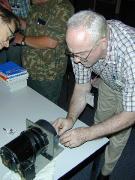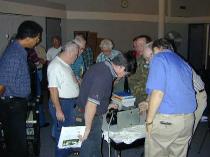

Letter From the Editor
First I would like to apologize to everyone for letting you down last month. I couldn't find the time among numerous other commitments to get the newsletter done. Since the Home Metal Shop Club was formed there have been few occasions when we didn't publish a newsletter.
This brings up the second subject. My level of personal and business commitments makes it necessary that I resign as newsletter editor. I had hoped to be able to continue with the help of Bob Lester and David Whittaker. Although they have done very well in supporting this effort I find that I don't have the time to organize and collect the inputs each month.
The efforts that the Home Metal shop Club has put into creating a quality newsletter and website distinguish us from the other clubs. On my several trips to NAMES when people learn I'm from Houston they frequently comment, " You are the guys with the neat website." Most of the material on the website is from our newsletter.
This leads us to "How do we publish a quality newsletter?" Perhaps a separate study group to examine this and report back to the group would be in order.
September Meeting Minutes
None available
September Meeting Photos
Joe Williams Diamond Tool Grinder
 |
 |
It's almost impossible to have a home metal shop and not modify some tool, or even better, a household appliance. It's in the genes. Quoting most wives, "To a man with a hammer, everything looks like a nail".
Part of this "home improvement" is the selection of replacement material. Something stronger, something heavier, or something stiffer sounds really good. So, below is a short list of excuses to modify just about anything. Figure 1 lists key mechanical properties of common materials.
Of course, if you're going to melt something, you need to know the melting temperature. This number is the most frightening of all properties, so tell her that value first. With some good negotiating tactics, you can probably trade that replacement washing machine pulley cast from homemade steel, for a billet aluminum sheave machined on that lathe you've been wanting to buy. It's all in the salesmanship.
| Material | Melting Point (deg F) |
Strength (psi) | Compressive Strength (psi) |
Weight (lb/ft3) | Coefficient of Thermal Expansion (inch/inch per Deg F) |
Modulus of Elasticity (psi) |
| Steel | 2700 | 70,000 | 70,000 | 490 | 6.5 x 10 | 30 x 10 |
| Wrought Iron | 2600 | 40,000 | 40,000 | 484 | 6.5 x 10 | 28 x 10 |
| Stainless Steel | 2500 | 95,000 | 95,000 | 494 | 9.6 x 10 | 28 x 10 |
| Gray Cast Iron | 2400 | 35,000 | 110,000 | 482 | 6.0 x 10 | 15 x 10 |
| Brass | 1720 | 55,000 | 55,000 | 529 | 10.3 x 10 | 15 x 10 |
| Bronze | 1700 | 60,000 | 60,000 | 548 | 10.0 x 10 | 16 x 10 |
| Aluminum | 1220 | 40,000 | 40,000 | 170 | 12.8 x 10 | 10 x 10 |
| Delrin | 347 | 10,000 | 18,000 | 89 | 58 x 10 | 1.00 x 10 |
| Plexiglass | 320 | 7,000 | 13,000 | 72 | 39 x 10 | 0.40 x 10 |
| Nylon | 300 | 11,000 | 10,000 | 70 | 50 x 10 | 0.35 x 10 |
| PVC | 260 | 8,000 | 13,000 | 88 | 20 x 10 | 0.80 x 10 |
| Polystyrene | 250 | 5,000 | 11,500 | 60 | 100 x 10 | 0.05 x 10 |
| Southern Pine | --- | 2,600 | 2,200 | 26 | 2.0 x 10 | 1.80 x 10 |
Other useful properties in Figure 1 include the material tensile and compressive strengths. These are the allowable forces per unit area that can be safely supported by the material. Steel can support 70,000 pounds per square inch (in tension or compression) while aluminum can only support 40,000 psi. Also in the above table, steel weighs approximately 490 pounds per cubic foot, while aluminum weighs substantially less (170 pounds per cubic foot).
The coefficient of thermal expansion is the rate that the material will expand as the temperature rises. Steel expands at approximately 6.5 x 10-6 inches per inch of length per degree Fahrenheit. In other words, a 100 inch length of steel will expand 0.065 inches when its temperature is raised 100 degrees F. Aluminum will expand at almost twice the rate of the steel (12.8 x 10-6 inches per inch of length per degree Fahrenheit).

As shown in Figure 2, the modulus of elasticity is a measure of material stiffness (the amount of deformation due to load). The higher the modulus, the smaller the deformation due to load. From Figure 1, the modulus of elasticity for steel is approximately 30 x 106 psi. It is interesting to note that, since all grades of steel have about the same modulus, there is virtually no reduction in deformation if a high-strength alloy steel is substituted for a low-strength carbon steel. However, when compared to aluminum, steel has about 3 times the stiffness.
Another way to view material properties is on a relative basis. Figure 3 is a repeat of Figure 1, with all values calculated as a ratio to steel. For instance, aluminum weighs about 35% the weight of steel. Brass has 79% of steel's tensile and compressive strengths, and Plexiglass expands at 600% the rate of steel. Gray Cast Iron has only 50% of the stiffness of steel.
| Material | Tensile Strength (Compared to Steel) |
Compressive Strength (Compared to Steel) |
Weight (Compared to Steel) |
Coefficient of Thermal Expansion (Compared to Steel) |
Modulus of Elasticity (Compared to Steel) |
| Steel | 100% | 100% | 100% | 100% | 100% |
| Wrought Iron | 57% | 57% | 99% | 100% | 93% |
| Stainless Steel | 136% | 136% | 101% | 148% | 93% |
| Gray Cast Iron | 50% | 157% | 98% | 92% | 50% |
| Brass | 79% | 79% | 108% | 158% | 50% |
| Bronze | 86% | 86% | 112% | 154% | 53% |
| Aluminum | 57% | 57% | 35% | 197% | 33% |
| Delrin | 14% | 26% | 18% | 892% | 3.30% |
| Plexiglass | 10% | 19% | 15% | 600% | 1.30% |
| Nylon | 16% | 14% | 14% | 769% | 1.20% |
| PVC | 11% | 19% | 18% | 308% | 2.70% |
| Polystyrene | 7.10% | 16% | 12% | 1538% | 0.20% |
| Southern Pine | 3.70% | 3.10% | 5.30% | 31% | 6.00% |
So, if you want to improve that tool or appliance, it is usually worthwhile to compare the important material properties. Figure 3 may not be a complete list, but it is a place to start.
